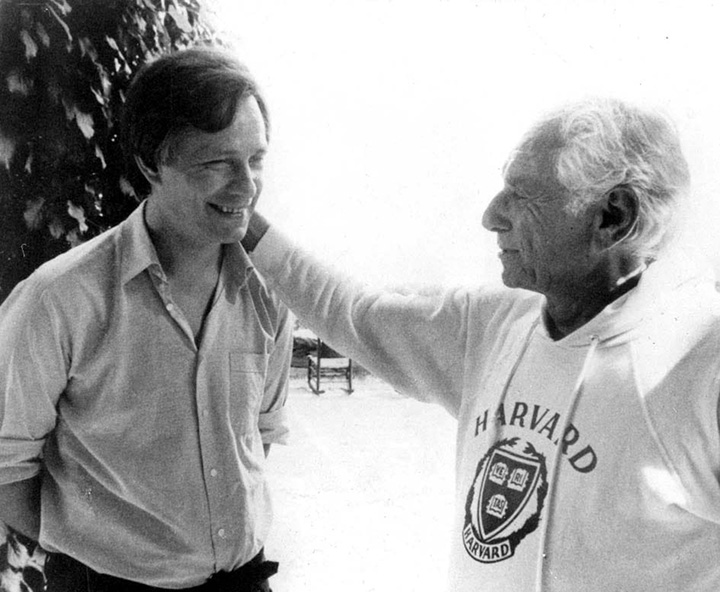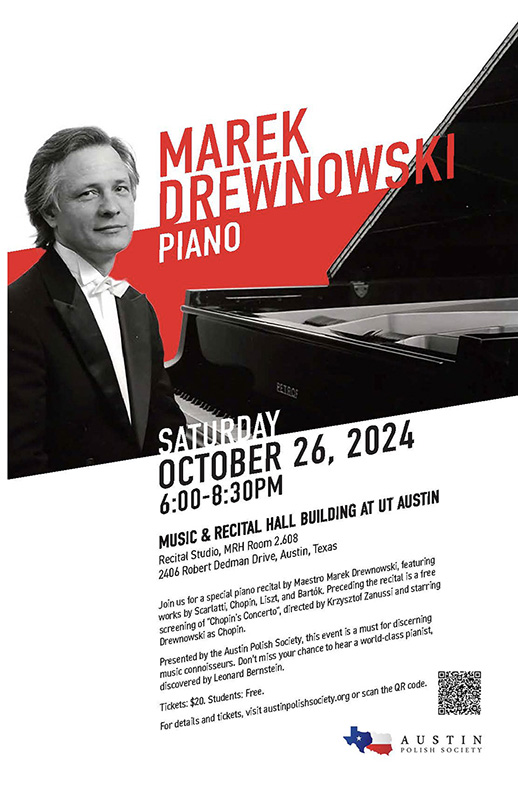The Wisdom of a Great Master
A Memory of the American Debut with Leonard Bernstein
*

*
Marek Drewnowski (Poland/Italy)
Many years have passed since my debut at Tanglewood in 1985, but each time I return to the U.S., the memories come rushing back with great intensity. The experience of performing with Leonard Bernstein and the Boston Symphony Orchestra, as well as Brahms’ First Piano Concerto, has stayed with me, and I find it difficult to escape those memories.
My musical adventure with Leonard Bernstein began in an unexpected way. One morning, Bernstein woke up in his New York apartment and turned on the radio. The station was airing some of Domenico Scarlatti’s Sonatas. The performance intrigued Bernstein so much that he waited until the end of the broadcast to find out who the performer was. However, the announcer didn’t mention it. Bernstein, still curious, called the radio station, but the staff claimed there hadn’t been any broadcast of Scarlatti’s Sonatas at that time.
Had the radio mentioned the pianist’s name, the story might have ended there. But Bernstein was determined to find out who the performer was. To this day, I still marvel at his persistence, character, inquisitiveness, and sheer tenacity. It’s hard to imagine another musician in the world showing such determination. Bernstein enlisted a whole team of “detectives,” including his assistant, Harry Kraut. After extensive searching, they finally discovered that it was my recording of Scarlatti’s Sonatas, my first album … recorded in 1976. How it found its way onto New York radio remains a mystery. Most likely during the broadcast, there had been a gap in the schedule, and they filled it with my sonatas.
Bernstein’s curiosity was piqued by the challenge of identifying this unknown musician, and he decided to track me down. At the time, I was living in Rome, but because of my typically Polish surname, the search led to Poland. They eventually found me through Pagart, the old Polish artistic agency I had worked with. Pagart located my address in Rome and sent me a telegram that read: “We received a message from New York. Mr. Leonard Bernstein is trying to contact you.”
Imagine my reaction—disbelief, then euphoria, followed by uncertainty and suspicion. The next day, I cautiously contacted Pagart, and they confirmed the news.
My first meeting with Leonard Bernstein took place at La Scala in Milan, where he was rehearsing his operas A Quiet Place and Trouble in Tahiti. When he saw me, he seemed visibly surprised. He had expected an older, serious-looking professor, but instead, I was young and casually dressed in a t-shirt. Bernstein took me by the arm and led me to the nearest camerino (a small dressing room). In front of the entire theater, he asked me to play a few of Scarlatti’s sonatas. Naturally, this caused quite a stir, as there was a break in rehearsals, and many people crowded in or stood in the hallway. I was surprised by the applause and Bernstein’s own reaction—he took my hand and kissed it.
I stayed in Milan until the premiere of Trouble in Tahiti. During that time, I met Bernstein’s circle of friends, including the Ricordi family, known for their publishing work– Madine Ricordi, her four sons, and her father-in-law Gianandrea Gavazzeni, with whom I later toured Italy with Mendelssohn’s Piano Concerto No. 2.
However, nothing at the time suggested any further musical collaboration with Bernstein. Although Bernstein invited me and his friends to his rented villa, to restaurants, and to the Ricordi home, these were just pleasant meetings that ended like all beautiful moments. Bernstein returned to America and I went back to Rome, I assumed our paths had diverged.
Back in Rome, I returned to reality, gradually forgetting the Milan adventure, focusing on my work, including a theater production of Mussorgsky’s Pictures at an Exhibition with moving paintings by Wassily Kandinsky, in collaboration with a theater group from Berlin. The production was a great success, and we performed it in many Italian cities and theaters, including the Teatro Olimpico in Rome, before ending the tour in Berlin. In Berlin, the final performance took place on Christmas Eve or the day before. I remember walking back to the hotel through the snow when I received a surprise call from Harry Kraut. He bluntly asked which Brahms concerto I wanted to perform at the Tanglewood Festival, the First or the Second, and which one I usually played. I took a deep breath and, fearing he would hear my thoughts, I quickly blurted out, “the First.” “Great,” he replied, “you’ll play it with Lenny at Tanglewood,” and hung up. (Lenny being Leonard Bernstein, ed.).
My quick response was a bluff. While I had studied Brahms’ First Piano Concerto with Professor Jan Hoffman in Kraków, it had been a long time since I had played it, and I wasn’t sure if I still remembered it. Fortunately, Kraut didn’t go into details, and I didn’t have to explain myself.
When I returned to Rome, I immediately rushed to find the score and started preparing. I had nearly six months to prepare. The challenge was that I had no opportunity to rehearse the concerto with an orchestra. It was impossible to find any orchestra within a few months. In Poland, strikes, arrests, and political turmoil made rehearsals impossible, and in Italy, where I was in exile, I had no such contacts. All I had was the score, my imagination, and the mounting pressure of preparing for Tanglewood and the stress of wondering whether I’d be ready in time.
In early July, I began preparing for my trip to the US, arranging the visa and the journey. I took the most affordable flight through Zagreb, followed by a ride on a Bonanza bus from New York to Tanglewood. It was madness, and to this day, I have no idea who guided me through that journey. Upon arriving, I felt like I had stepped into a Western movie, greeted by a few guys sitting outside a bar with beers in hand and looking at me with great surprise. I asked them where can I find a taxi. “There are no taxis here,” I heard. “What are you doing here?” “I came for the festival…” “What hotel?” I explained… “I’ll take you there for five dollars.” And that’s how I arrived at the Tanglewood Festival to play Brahms’ First Piano Concerto with Leonard Bernstein.
One evening, Bernstein shared a story about the famous Canadian pianist Glenn Gould and his controversial performance of Brahms’ First Concerto. Gould, a great eccentric and a great musician, called Bernstein to announce his discovery related to the concerto. He invited Bernstein to his home in Toronto, Canada. Gould and Bernstein drove around Toronto, Gould dressed in a Siberian fur coat, setting the car’s temperature to full blast, and explaining his insights about the concerto.
It was about the tempo of the concerto. Gould came up with an extremely slow tempo. So slow that the concerto stretched to gargantuan proportions. The first movement alone was supposed to last longer than the entire concerto played by other pianists. Gould argued that the concerto would gain multiple dimensions and become groundbreaking and innovative.
Bernstein, known for his temperament, couldn’t agree with this concept. After returning to New York, he informed the musicians of the New York Philharmonic that Gould’s concept was debatable and that there would be issues during rehearsals. He asked the orchestra for patience. Before the concert, Bernstein came out to the audience and said that he didn’t agree with Gould’s interpretation but, “for sport” and out of admiration for Gould, he agreed to the performance. The concert took place as Gould wished. There is a recording of that concert.
But what hurt Bernstein the most was a review by the leading critic of The New York Times, Harold C. Schonberg, who wrote sharply: “For the first time in my life, I saw a conductor betray his soloist.” It was evident from our conversation that it still caused him pain. He said that Gould had agreed to the public appearance and that he had been misunderstood.
I mention this story about Gould because, at that time, I was about to play the same concerto.
I was driving to the concert hall in Tanglewood, and from the window, I could hear the murmur of the twelve-thousand-strong audience. I felt uneasy. Waiting for me at the hall’s entrance was Leonard Bernstein, along with the famous Boston Symphony Orchestra, and the news that I would have to wait for the radio broadcast, which was being aired across America. I walked onto the stage, greeted the orchestra and the audience. Before me stretched a sea of heads. Bernstein began the orchestra’s performance. They played wonderfully. Bernstein’s phrasing floated over the hall and the people sitting in the back on the lawns. The hall has excellent acoustics, despite the lack of a rear wall. I listened to the orchestra and waited for my entrance. I began, still tense—the first trills were fast, the octaves imprecise—but as time passed, the tension eased, and I found my way back to the music.
Bernstein set the tempo. It was slow—though not as slow as Gould’s—but still deliberate. With each passing minute, I gained more energy, yet Bernstein kept me restrained with his conducting. I wanted to push forward, but he held firmly to his chosen tempo.
As one listener commented after the concert: “Tremendous performance. Wasn’t familiar with this pianist. It only took 23 years, but Lenny finally came around to Glenn Gould’s conception of the tempo for this piece.”
After the first movement, calm returned, as did poetry, pathos, and beauty. The tempo was right, and the orchestra’s entrances were magnificent. In the third movement, I allowed myself more freedom, although my temperament took over at times, Bernstein kept me in check. The entrance to the fugue was flawless, and both the cadenza and coda were virtuosic. Applause and ovations quickly followed.
The fusion of great musical ideas from Gould and Bernstein produced extraordinary results.
Being in the midst of these great musical ideas and extraordinary musicians, I received a profound lesson in Music—and not just in music, but also in life and psychology. Whenever I listen to the recording of that concert, I still get chills as the emotions flood back. I have never encountered such phrasing in any other orchestra or recording as I did with the Boston Symphony and Bernstein. That recording represents the collision of a young, ambitious pianist with the wisdom of a great Master.
That’s why each time I return to the U.S., as I am now for this concert in Austin, Texas, the memories of my American debut come flooding back with great intensity. These memories will stay with me forever.
(Marek Drewnowski, at Leonard Bernstein’s special request, performed under his baton again in 1989 during a special concert commemorating the 50th anniversary of the outbreak of World War II. The event brought together other world-renowned artists such as Barbara Hendricks, Hermann Prey, and Liv Ullmann, and was broadcast by television stations worldwide, ed.).
Prepared by Joanna Sokołowska-Gwizdka.
